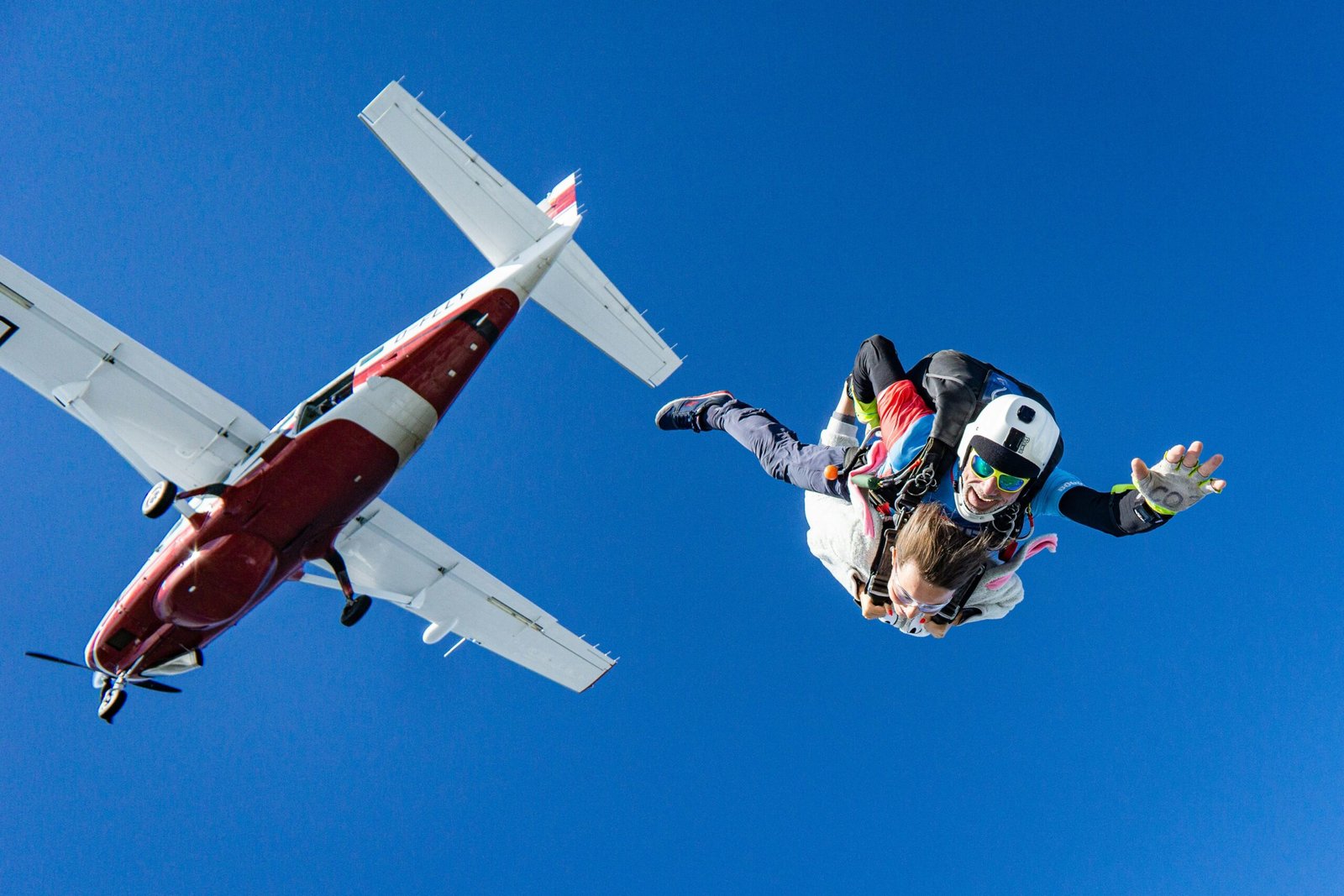
Is Skydiving Safe? Complete Guide For Beginners
Skydiving refers to the use of a parachute to glide through the air while minimizing friction and ensuring the stability of a person. It is usually done for recreational purposes, though it can also be competitive. Skydivers jump from an aircraft at a certain altitude in the sky or from a high place. This activity is mesmerizing for travelers, as they can experience the thrill of descending from the sky while enjoying a bird’s-eye view.
Many first-timers wonder, “What to wear skydiving?” It’s essential to choose comfortable, loose-fitting clothes paired with a standard jumpsuit provided by the skydiving center. Tight clothes can cause discomfort, while the jumpsuit protects against air friction and keeps the harness in place.
Safety Measures During Skydiving
Skydiving is considered a safe activity when performed with proper equipment and training. However, the idea of jumping from thousands of feet in the air can understandably raise concerns. Many ask, “Is skydiving safe?” Statistically, the average death rate at skydiving places is remarkably low—roughly 0.39 fatalities per 100,000 jumps, according to the United States Parachute Association (USPA). This means that for every 250,000 jumps, only one fatality occurs on average.
This low rate is due to advancements in skydiving technology, the mandatory use of reserve parachutes, and stringent safety regulations. While accidents can happen, they are often attributed to factors like weather conditions or human error rather than equipment failure.
Mechanism of a Skydive
Before the adventure begins, skydivers undergo thorough instructions and safety drills. They receive training that explains the mechanism of a parachute, aerodynamics, and the physical preparation needed. All of this is guided by experienced instructors to ensure safety.
Skydivers usually jump from heights of 2,500 meters to 4,600 meters above the ground, experiencing about 40 to 80 seconds of freefall. Competitive jumps may have different requirements. Skydivers must deploy their parachute at a safe altitude to ensure a smooth landing.
In freefall, a skydiver’s body is positioned belly-down with arms and legs spread to maximize air resistance. This slows the descent, giving them time to enjoy the view. Recreational jumpers sometimes perform flips or tricks, while competitive skydivers may adopt a streamlined pose for a faster descent.
For enthusiasts wondering, “Do you BASE jump with a reserve parachute?” the answer is typically no. BASE jumping involves lower altitudes, which limit the time available for deploying a reserve. This is why it’s considered riskier than traditional skydiving.
Essentials for Making a Skydive
- Goggles: Goggles help skydivers see the sky view. The friction in the air makes it almost impossible for skydivers to keep their eyes open. Goggles are of utmost importance for skydiving, similar to deep-sea diving.
- Adjustable Harness: A harness attaches the skydiver to the parachute, keeping them safe during skydiving. During training, the harness is often attached to the instructor to ensure the divers’ safety.
- Helmet: A helmet protects the skydiver’s head from dangerous impacts with the ground. It also keeps the hair in place during skydiving.
- Dual Parachute: Every skydiver is equipped with a primary and reserve parachute for safety. If you’re curious, “Could you buy a parachute?”—yes, licensed individuals can purchase one, but proper training is essential before use.
- Jumpsuit: Skydivers wear a jumpsuit to protect themselves from the air friction at high altitudes. The jumpsuit is made of synthetic fabric and is equipped to hold the harness and carabiners in place. The loose fit allows air to flow through, maximizing friction.
- Automatic Activation Device (AAD): This high-tech device, attached to the skydiver’s parachute, ensures the deployment of the backup parachute if the skydiver is unable to deploy it or becomes incapacitated. It contains a microchip processor.
- Altimeter: An altimeter is an electronic device attached to the skydiver, showing their current altitude. It’s essential for parachute deployment, as it depends on altitude.
- Flysight: Flysight is a GPS tracking device attached to skydivers for safety purposes. If they don’t land at the specific site or become lost, the GPS tracker aids in their rescue.
For those unsure what to wear skydiving, comfort is key. Pair athletic shoes with the provided jumpsuit, and avoid accessories that could interfere with the harness or equipment.
Safety Measures During Skydiving
Skydiving is a risky recreational activity, and injuries can occur due to carelessness. To minimize the possibility of accidents, caution is key. Certain measures are taken before and during skydiving to keep skydivers safe:
- Every skydiver must undergo required training before skydiving.
- They must gain practical knowledge of parachutes and other skydiving equipment before boarding the aircraft.
- Physical fitness is crucial for skydivers. Individuals prone to heart conditions, high blood pressure, anxiety, and panic attacks are advised to avoid skydiving due to potential health risks.
- Skydivers should properly check their suits and equipment before a dive.
- Loose-fitting clothes and the standard jumpsuit are recommended. Tight-fitting clothes that may cause discomfort are not advised.
- Skydivers should remove any jewelry or accessories that could get caught on the jumpsuit or harness.
- Ensure the harness isn’t jammed and vision isn’t hindered.
- Correct altitude for the jump and parachute deployment is crucial to avoid accidents.
The S&TA
The S&TA stands for Safety and Training Advisor. An S&TA is present at every skydiving drop zone and is responsible for providing sufficient training and equipment for skydivers. They also regulate safety measures to ensure a safe skydiving experience for everyone.
Beginners Questions About Skydiving
- Is there a weight limit for skydiving? Yes, most skydiving centers have weight limits for safety reasons. Generally, the weight limit for skydiving is between 200 to 240 pounds (90 to 109 kg) for men and 180 to 220 pounds (82 to 100 kg) for women. Some centers may offer flexibility depending on body size and shape, but it’s important to check with the specific skydiving company.
- Is solo skydiving more dangerous? Solo skydiving is generally considered more challenging and potentially riskier than tandem skydiving. Because, skydiving solo, you need to be fully responsible for managing your own parachute deployment, body position, and landing, which requires extensive training and experience. So if you are not experienced then we suggest you to go for tandem skydiving.
- How much does skydiving cost? The cost of skydiving can vary depending on several factors, including location, type of jump, and the company you choose. Here’s a general breakdown of typical skydiving costs: 1. Tandem Skydiving (Most Popular for First-Timers): $200 to $300 (USD) 2. Accelerated Freefall (AFF) (Solo Jump Training Course): $1,500 to $3,000 for a full course. 3. Solo Skydiving (Licensed Skydivers): $25 to $100 depending on equipment rentals and location. Mostly, skydiving companies offer video/photo package. They charge extra $50 to $100 for that.
- How old do you have to be to go skydiving? In most countries, the minimum age for skydiving is 18 years old. This is a common standard, especially in the United States. A few countries, like Australia or the U.K., the minimum age might be 16.






